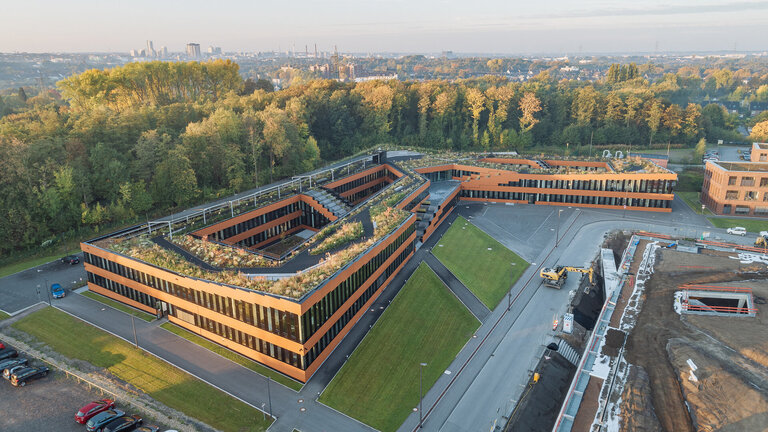With the German Sustainable Building Award (Bundespreis Umwelt und Bauen), the German Federal Ministry for the Environment and the Federal Environment Agency honored sustainable and innovative construction projects on September 29. The new building for the RAG Foundation on the Zollverein world cultural heritage site, in the German city of Essen, was recognized in the Special Award category.
Designed by Aachen-based architecture firm kadawittfeldarchitektur and completed in 2017, the new building on the site of the Zollverein coal mine conforms to the latest standards of sustainability. Not only does it meet the standards for Platinum certification by the German Sustainable Building Council (DGNB), but it is also one of the first buildings in Germany to be built according to the Cradle to Cradle (C2C) design principle. This concept is based on the idea of selecting and designing the materials for use in a building in such a way that, after use, they can be returned either to the natural nutrient cycle or to the technical cycle. In this way, buildings act as depositories for raw materials, releasing their resources for new products and projects when they reach the end of their useful lives.
With these issues in mind, Jasna Moritz, Partner at kadawittfeldarchitektur, commented: ‘We would especially like to thank Drees & Sommer and EPEA, who helped us to understand the C2C concept and provided support on the project with their pioneering expertise in recyclable building. The award also inspires us to continue pursuing the concepts already developed and the direction we have already taken with regard to current and future projects.’ In addition to providing Cradle to Cradle consulting on the showcase project, experts from EPEA and Drees & Sommer were also responsible for the general technical planning.
In line with the C2C principles, the new RAG Foundation administration building was constructed from regional and fully recyclable materials. For instance, the ribbon windows consist of a frame construction made of C2C-certified aluminum profiles and glass. Carpet tiles with particulate-binding properties and oak parquet flooring were used in the building as C2C-certified floor coverings, in addition to a C2C-certified glass partition wall system. Sustainable production and use of energy are provided by a geothermal system and a solar pergola integrated into the roof. Additionally, the green roof promotes biodiversity and compensates for the ground area used up for the construction of the building.
These innovative and sustainable solutions impressed the interdisciplinary jury for the German Sustainable Building Award. The official awards ceremony, involving four prizewinners and seven awards, took place on September 29.
Further information on the German federal award for sustainable buildings, neighborhoods and ecological innovation can be found here (in German):
https://www.umweltbundesamt.de/bundespreis-umwelt-bauen-start
